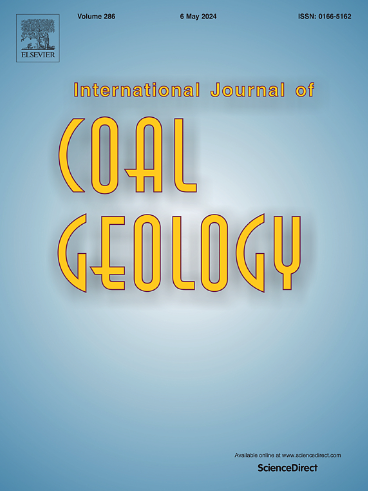Palaeoenvironmental reconstruction of the coal-forming conditions during Oligocene in Niger Delta, Southern Nigeria: Implications for organic matter preservation and hydrocarbons potential
IF 5.7
2区 工程技术
Q2 ENERGY & FUELS
引用次数: 0
Abstract
Twenty eight (7 coal, 12 organic-rich and 9 inorganic) cutting samples obtained from six boreholes drilled over a c. 60-km2-large area in the alluvial plain of Niger River between Obomkpa and Issele-Azagba, southern Nigeria, were examined and evaluated by means of coal-petrography, mineralogical (XRD) and geochemical (CHNS, Rock Eval, XRF) analyses. This study aimed to provide an initial assessment of the palaeoenvironmental conditions during the Oligocene-Miocene peat accumulation.
As the samples were received a long time after sampling, moisture could not be determined. The ash and the volatile matter yields of the samples vary from 19.9 to 88.5 wt% (db) and 63.5–67.9 wt% (daf), respectively. Huminite is the dominant maceral group ranging from 60.6 to 90.6 vol% (on mineral matter-free basis), with detrohuminite being the major sub-group. The inertinite content is very low (<1.5 %), whereas liptinite macerals are frequent to quite enriched (8.8–37.9 %) with alginite and liptodetrinite being the most common. The mean random huminite reflectance of all the coal samples varies between 0.32 % and 0.39 %.
As mainly sandstones, intercalated with siltstones and claystones are the main sedimentary rocks deposited in the Niger-River alluvial plain, the inorganic part of all the studied coaly and carbonaceous samples consists primarily of quartz and kaolinite, whereas goethite, mixed clay layers (illite-montmorillonite), anatase and gypsum occur in minor amounts. Accordingly, SiO2 and Al2O3 display values ranging from 9 to 58 % and up to 23 wt%, respectively, while Fe2O3 up to 12 wt% and TiO2 up to 2 wt%.
Palaeoenvironmental geochemical proxies indicate a mixed source area for the siliciclastic facies, with significant recycling and weathering, deposited under a pure freshwater regime. The carbonaceous layers seem to have been deposited in a relative semi-arid climate, while the palaeomires were established under a more humid regime, promoting anaerobic conditions, which is in agreement with the observed very low inertinite content. Facies diagrammes based on the maceral contents were applied to reconstruct the environmental conditions in the palaeomires. According to the TPI vs. GI diagramme, the peat-forming vegetation was mostly herbaceous yielding low TPI and medium GI values, and the conditions were fluvial-limnotelmatic. The GWI vs. VI diagramme points to herbaceous vegetation on the palaeomire surface and mesotrophic water conditions with intense mineral matter influx from palaeo-Niger River. The area received frequent rainfall along with river flooding; thus, peat remained water-logged. Within the several hundred metres thick alluvial sediments, only short periods of limnotelmatic conditions prevailed in the area, yielding coal beds less than 17 m thick. The small number of the available cores distributed over a large area does not allow a more detailed palaeoenvironmental reconstruction.
尼日利亚南部尼日尔三角洲渐新世成煤条件的古环境重建:有机质保存和油气潜力意义
在尼日利亚南部Obomkpa和Issele-Azagba之间的尼日尔河冲积平原上,从6个钻孔中获得了28个(煤样7个,富有机质12个,无机9个)切割样品,通过煤岩学、矿物学(XRD)和地球化学(CHNS, Rock Eval, XRF)分析进行了检查和评价。本研究旨在对渐新世-中新世泥炭沉积的古环境条件进行初步评价。由于样品在取样后很长时间才收到,所以无法测定水分。样品的灰分和挥发物得率分别为19.9 ~ 88.5 wt% (db)和63.5 ~ 67.9% wt% (daf)。腐殖石是主要的矿物群,占60.6 ~ 90.6 vol%(以无矿物为基础),脱腐殖石是主要的亚群。惰质岩的含量很低(1.5%),而脂质岩的矿物则较为丰富(8.8 - 37.9%),以藻褐岩和脂质泥质岩最为常见。所有煤样的随机腐殖岩平均反射率在0.32% ~ 0.39%之间。尼日尔河冲积平原的主要沉积岩为砂岩、粉砂岩和粘土夹层,煤质和碳质样品的无机部分主要为石英和高岭石,而针铁矿、混合粘土层(伊利蒙脱石)、锐钛矿和石膏含量较少。因此,SiO2和Al2O3的显示值分别为9 - 58%和23 wt%,而Fe2O3的显示值为12 wt%, TiO2的显示值为2 wt%。古环境地球化学指标表明,该区为硅屑相混合源区,具有明显的再循环和风化作用,沉积在纯淡水环境下。碳质层似乎是在相对半干旱的气候下沉积的,而古岩浆岩是在更潮湿的环境下建立的,促进了厌氧条件,这与观察到的极低的惰质含量是一致的。基于显微组分含量的相图重建了古沉积的环境条件。从TPI - GI图上看,泥炭形成植被以草本植物为主,TPI低,GI值中等,条件为河流-界线化。GWI vs. VI图显示了古泥岩表面的草本植被和中营养水条件,古尼日尔河的矿物质流入强烈。该地区降雨频繁,河水泛滥;因此,泥炭一直处于浸水状态。在数百米厚的冲积沉积层中,该地区只有短时间的边缘沉积条件,产生的煤层厚度不到17米。分布在大面积上的少量可用岩心无法进行更详细的古环境重建。
本文章由计算机程序翻译,如有差异,请以英文原文为准。
求助全文
约1分钟内获得全文
求助全文
来源期刊

International Journal of Coal Geology
工程技术-地球科学综合
CiteScore
11.00
自引率
14.30%
发文量
145
审稿时长
38 days
期刊介绍:
The International Journal of Coal Geology deals with fundamental and applied aspects of the geology and petrology of coal, oil/gas source rocks and shale gas resources. The journal aims to advance the exploration, exploitation and utilization of these resources, and to stimulate environmental awareness as well as advancement of engineering for effective resource management.
 求助内容:
求助内容: 应助结果提醒方式:
应助结果提醒方式:


